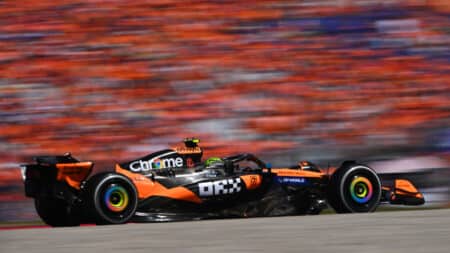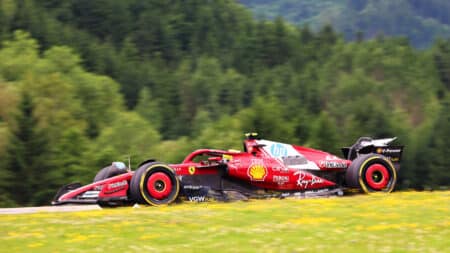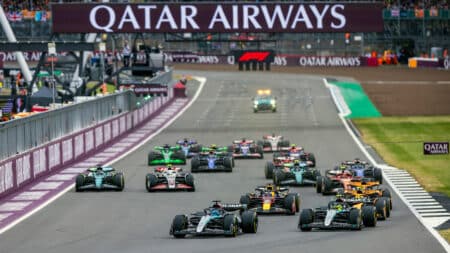Spa 1955.
In the early laps of the Belgian Grand Prix, behind the Mercedes W196s of Juan Manuel Fangio and Stirling Moss, Lancia’s Eugenio Castellotti and Ferrari’s Giuseppe Farina are scrapping over third place, and it is very much the F1 apprentice against the proud veteran. Castellotti is young, perhaps a little too eager, Farina already 48, at the tail-end of a distinguished career.

A great driver Farina undoubtedly was, and a beautiful stylist with it, but there was also a less palatable side to the man: he was singularly ruthless at a time when ‘dirty driving’, as Stirling Moss and others used to call it, was most uncommon, not least perhaps because the consequence of an accident back then was so often fatal.
On one lap at Spa, Denis Jenkinson told me, Farina narrowly led Castellotti out of La Source, but as they headed down the hill – where the pits and start-finish line used to be – the Lancia jinked right, trying to pass the Ferrari before Eau Rouge. Instantly Farina moved the same way, edging Castellotti ever closer to the pits – where there was no barrier, of course, and where mechanics were standing. Jenks was in someone’s pit at the time, standing on the wall, and he described it as a moment of pure horror – and a miracle that no one was killed.
Farina had done it without a thought – but then this was the same man who had impatiently turfed Marcel Lehoux’s ERA off the road, while lapping it en route to victory in the one-off Deauville Grand Prix in 1936. Lehoux was killed.

Moss said that Farina was unusual in that era of motor racing. There were others, too, who were less than ‘clean’ – including one or two British household names – but none as brutal and uncompromising as the man forever remembered as the sport’s first World Champion.
In those times, of course, Grand Prix racing was unrecognisably different from the way it is today. Even in the event of a fatal accident, even when a circuit was effectively blocked by wreckage – as at Monaco in 1950 – there was never any question of stopping a race. It wasn’t until ’52 that crash helmets were made compulsory, not until 1966 – after his accident at Spa – that Jackie Stewart pioneered safety belts in F1 cars. Fatal accidents were frequent, and Stirling concedes that the dangers undeniably instilled a discipline in the drivers; beyond that, though, he insists that back then there was a certain etiquette in motor racing – call it ‘sportsmanship’, if you like, as quaintly old-fashioned as the word sounds in the 21st century.
Fundamentally, that held true for a very long time. In the early ‘70s a somewhat inconsequential driver named Mike Beuttler was known in the business as ‘Blocker’ because he was notoriously difficult to pass (more usually to lap), frequently moving over on faster drivers. The very fact that he acquired such a nickname shows how untypical were his track manners back then.

I will always think of September 25, 1988 in Estoril as the day everything began to change. Ayrton Senna led the first lap of the Portuguese Grand Prix, but at the end of it his McLaren team-mate Alain Prost pulled out to pass him – and as he did so, Senna swerved right, moving Prost dangerously close to the pit wall. Alain didn’t lift, and went on to win the race, but afterwards he confessed that he had been shaken by Ayrton’s move. So were all who witnessed it – and why? Because we had never seen the like of it before.
That was nearly a quarter of a century ago, and although Michael Schumacher was widely criticised for a similar move on Rubens Barrichello at the Hungaroring in 2010, it has now long been the norm for Grand Prix drivers to ‘protect their position’ by chopping across the nose of a would-be overtaker – indeed, while it may not be actually enshrined in the rules, it is tacitly acceptable these days to make ‘one move’ to block the path of a faster car behind you.
No one, least of all myself, wants to see F1 become soft. It is the summit of motor racing, featuring the best drivers on earth, and hardly a place for ‘after you, Claude’. It should always be tough and hard – but so should it always be fair. I thought Gilles Villeneuve the perfect exponent of this: watch again his battle with Rene Arnoux at Dijon in 1979, and you will see that neither man, down the long pit straight, ever changed his line to block his rival. Indeed, Gilles was contemptuous of that sort of driving: “Any idiot can block,” he said.

Be that as it may, the culture now – ironically in this safety-obsessed age – is very different, so that blocking has become a way of life, and not anything that attracts criticism, let alone opprobrium, unless it’s extreme, as with Schumacher in Hungary.
It seems to me that as soon as you say ‘one move’ is permissible, you’re going to have problems, not least because some drivers appear to have a problem in counting. And what it has inevitably done is lead to lots of silly accidents or near-misses, all of which are these days instantly investigated by the stewards, advised by an ex-F1 driver such as Derek Warwick.
After taking out Lewis Hamilton and Fernando Alonso at the start of the Belgian Grand Prix, Romain Grosjean was handed a one-race ban by the stewards, and thus missed Monza. Had it been the first such happening, Grosjean might have got away with a grid penalty at the next race, but it was not: Romain has been mighty quick this year, but also – too often – mighty wild, not least in the opening seconds of a race. A problem that was displayed once again at the first corner of the Japanese Grand Prix, when he slammed into the back of Webber while he was “looking at Perez”. In Warwick’s opinion, the stewards had been entirely right in their decision on the Spa incident, and he said he was in favour of a ‘points system’, in which a driver incurred a certain number of points for a misdemeanour: when these reached a certain total within a certain time, a one-race ban would automatically follow. [Click here to listen to our podcast with Derek.]

Unquestionably drivers pull stunts today that would once – for reasons of simple self-preservation, let alone ethics – have been unthinkable, which is why the stewards are so often pressed into service. ‘Investigation into incident between cars X and Y’… how often these days we see such messages on the TV screens in the press room, and there invariably follows another, notifying us all of a ‘drive through’ penalty for one of the parties involved.
I found it interesting that the instant conclusion of many, following the multiple accident at Spa, was that ‘closed cockpits’ were now an inevitability in F1. Apart from the fact that such things would, in my opinion, cut across the whole ethos of what a Grand Prix car is supposed to be, it seemed to me that a more sensible plan in the short term would be to introduce effective mirrors – as Grosjean pointed out, the tiny things in use at the moment are virtually useless – and, even more fundamentally, to get it across to certain drivers that they should stop behaving like lunatics, both at the start and after.
Personally, I hate the ‘penalties’ syndrome, which has lately mushroomed in motor racing – particularly the loss of grid positions for engine or gearbox changes, when the only person who suffers is the blameless driver. But when it comes to punishment for plainly dangerous driving, that’s a different matter, and perhaps, if the thing had been nipped in the bud – as it should have been – at Estoril 24 years ago, we might have less of a problem today than we do. Gilles was indeed right: “Any idiot can block…”









